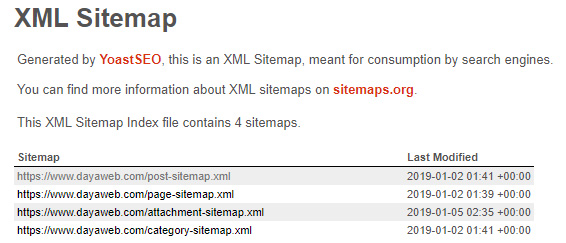What Is A Sitemap?
Sitemaps are files that list the URLs that belong to your website. Their primary usage is to notify search engines about all of the web pages that you wish to have crawled and indexed on your website. Sitemap files are submitted to search engines so that they can crawl and discover your website pages faster.What Does A Sitemap Look Like?
There are a few different formats for sitemap files, but the two most common formats are Text and XML:Text - a list of website URLs, each on a single line
https://www.dayaweb.com/
https://www.dayaweb.com/about/
https://www.dayaweb.com/testimonials/XML - a list of website URLs in XML format
<?xml version="1.0" encoding="UTF-8"?>
<urlset xmlns="http://www.sitemaps.org/schemas/sitemap/0.9">
<url>
<loc>https://www.dayaweb.com</loc>
<lastmod>2018-11-06</lastmod>
<changefreq>monthly</changefreq>
<priority>1</priority>
</url>
<url>
<loc>https://www.dayaweb.com/about/</loc>
<lastmod>2018-02-08</lastmod>
<changefreq>monthly</changefreq>
<priority>1</priority>
</url>
<url>
<loc>https://www.dayaweb.com/testimonials/</loc>
<lastmod>2018-02-02</lastmod>
<changefreq>monthly</changefreq>
<priority>1</priority>
</url>
</urlset>
- Date of last update
- Frequency of updates
- Relative importance (priority) of the page
Creating A Sitemap
There are many different ways that you can use to make a sitemap file. The way that you decide to use will probably depend on a few different factors:- The size of your website (i.e. number of pages)
- Your website platform (custom, WordPress, etc.)
- The technical skill that you have available
- Online tools (Sitemap Generators)
- Desktop applications
- WordPress plugins
- Manually creating one using a text editor
Online Tools
XML-Sitemaps.com
If you have a small website (less than 500 pages), then you can use an online tool like XML-Sitemaps.com. Simply enter in your main website URL and the tool will crawl your website and generate an XML-formatted sitemap file that you can download.
Desktop Applications
Screaming Frog SEO Spider
Screaming Frog SEO Spider is a desktop application that will crawl your website and generate a sitemap file. It is free for websites under 500 pages.
WordPress Plugins
Yoast
The Yoast SEO plugin for WordPress will automatically produce an XML sitemap that will include all of the pages on your site.
Manually Creating A Sitemap File
If you have a small website, you might be able to manually create a sitemap file on your computer. Sitemap files must be UTF-8 encoded, so you will need to use a plain text editor:- Windows - Notepad
- Mac - TextEdit
Upload Your Sitemap File
Completed sitemap files are usually uploaded to your website's document root. Once the sitemap file has been uploaded, you should also add the sitemap URL to your robots.txt file:robots.txt
Sitemap: https://www.dayaweb.com/sitemap.xmlValidate Your Sitemap File
The W3C Markup Validation Service
Once you've created your sitemap file, you should validate it using a validation service such as the W3C Markup Validation Service.